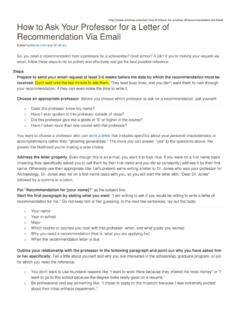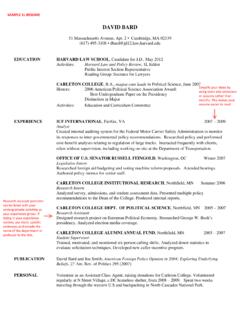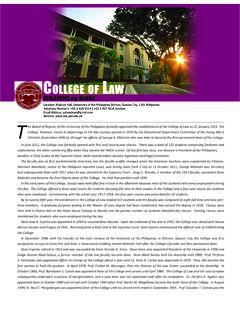Transcription of Writing Resumes for Scholarship/Admission Applications
1 Writing Resumes for Scholarship/Admission Applications This information will get you started. Produce a draft, and then get an advisor's help. What is a resume ? A resume is a data sheet that markets your credentials. It outlines your skills and qualifications and prompts potential employers to talk to you further about the opportunities they offer. A resume gets you in the door, but it doesn t get you the job. You ll get a job offer as a result of successful interviews. Create a Master List The first step is to recall and list every experience you can think of including volunteer/community service, internships, paid jobs, and major research projects. You should also list campus activities, student organizations, and all of your educational experiences.
2 Don t worry about the format yet. This master list will provide you with all the information you need to create your resume and cover letter and prepare for interviewing. Elaborate On Your List Next, write descriptions of the items on your list. Include information about your specific responsibilities, skills used, and outcomes you obtained. Use action verbs in your descriptions (see the Action Verb list below). Remember to tailor the descriptions to the types of jobs and employers you re targeting. Think about the skills you used in each of your positions that will be of interest to potential employers. You re trying to convince an employer that your skills transfer to the type of position for which you re applying.
3 Organize Your resume After you have written descriptions for your positions, you ll need to decide how to organize your experiences, and what to include in the resume . You do not need to include every experience in your list. Be strategic. Focus on those experiences that will be of most interest to your prospective employer. There are a few sections that are common to most Resumes : CONTACT INFORMATION It s a good idea to include both your current school address and a permanent address. Be sure that your phone numbers are correct, and always include an email address. You only need to list one email address, but be sure you check it frequently. If you use an email address other than your Oberlin one, be sure to use a professional sounding address.
4 Do not include your social security number or date of birth. OBJECTIVE This is optional. If you choose to include one, make it a concise declaration of the position you seek in a specified area, department, or industry a summer internship in a public relations firm. You will elaborate on this more fully in your cover letter, so if you can better use the space on your resume to list relevant experiences and skills, skip the objective. EDUCATION This section gives details about your college, degree, graduation date, and majors. An overall GPA and a Major GPA are optional. Typically, include your GPA if it is or higher and add your Major GPA if it is higher than your overall GPA.
5 Include study abroad or additional educational institutions if appropriate. Generally, you will not include high school, unless your high school is well known or is relevant to the employer (it is assumed you graduated from high school to get into college). EXPERIENCE This is the main part of your resume . Use the descriptions you wrote while compiling your list, being sure to begin them with action verbs. Strive to be concise. You should not use full sentences or try to write eloquent prose. Illustrate descriptions with specifics about numbers, outcomes, and goals you met. Omit all personal pronouns. Try not to be redundant with your job title. For example, if you were a staff writer for The Review, don t just say you wrote articles for The Review.
6 That is implied by your title. Instead try to indicate how many articles, about what, whether you conducted interviews, etc. Write the description of your experiences either using bullets or in a paragraph style. Again, make sure it is easy to read. Bulleted statements can contain more than one sentence and be more than one line if needed. Don t use bullets if you choose a paragraph style. Other sections will depend upon your background and what will be of interest to the prospective employer. You may include some of the following: SKILLS List your computer, language, and other relevant skills. ACTIVITIES/LEADERSHIP/EXTRACURRICULAR ACTIVITIES If not already included in the Experience section, use this section to describe activities you ve participated in, especially if you played a leadership role.
7 This section is especially useful for students and recent grads who do not yet have a great deal of work experience. PUBLICATIONS/PRESENTATIONS Particularly useful for academic Resumes , this section allows you to elaborate on relevant academic work you ve done. FIELDS OF INTEREST (major/minor; or possible fields of interest) VOLUNTEEER ACTIVITIES AWARDS Format Your resume After you have determined what information you would like to include in your resume , you must choose a format in which to present it. Most students and recent grads use some variation of a chronological format where experiences are listed in reverse chronological order (most recent first). You can list either your employer or your job title first typically you will start with whichever is stronger and be consistent.
8 You should emphasize experiences that are relevant to your objective or experiences that demonstrate specific transferable skills that would be needed. If these relevant experiences are not necessarily your most recent or are volunteer or extracurricular, you can still feature them first by using a Relevant Experience section. Give a good amount of detail and be specific in your descriptions. Other experiences can be listed under an Additional Experience section with much less description. Other formatting options include functional and combination Resumes . In these types of Resumes you describe experiences under specific skill headings (see sample below). Length: Your resume should be one page long.
9 Two-page Resumes are acceptable only under certain circumstances. Remember that employers spend very little time scanning your resume . Good information on the second page might never be seen. It s best to keep the resume succinct and leave out unrelated experience. If you must use a two-page resume , make sure your name is at the top of the second page. Appearance: There are many creative ways to design a resume . You want it to be easy to read, so have a good balance of text and white space. Don t try to be too creative. Stick to something that can be read quickly and easily. Margins: One-inch is standard, but you can use slightly smaller margins if needed. Make sure your resume is centered on the page.
10 Font Size/Style: An 11-inch font size is standard. Times and Times New Roman are two professional looking styles. Use only one font style in your resume . Finalize a Draft Print your resume on the same paper you will use for your cover letters. Do not use standard photocopy paper. Choose a conservative color: white, ivory, off-white, light gray or eggshell. Proofread, proofread, and proofread! Even if you use spell-check and grammar-check, proofread carefully and have your resume critiqued by at least one other person. The best way to proof your resume is to read it out loud to another person who has a copy of it. If your resume is for a specialized or technical field (science, theater or computer science for example), be sure to have a faculty member in your department look it over.


